tow CADILLAC SEVILLE 1996 4.G Service Manual
[x] Cancel search | Manufacturer: CADILLAC, Model Year: 1996, Model line: SEVILLE, Model: CADILLAC SEVILLE 1996 4.GPages: 354, PDF Size: 20.21 MB
Page 276 of 354
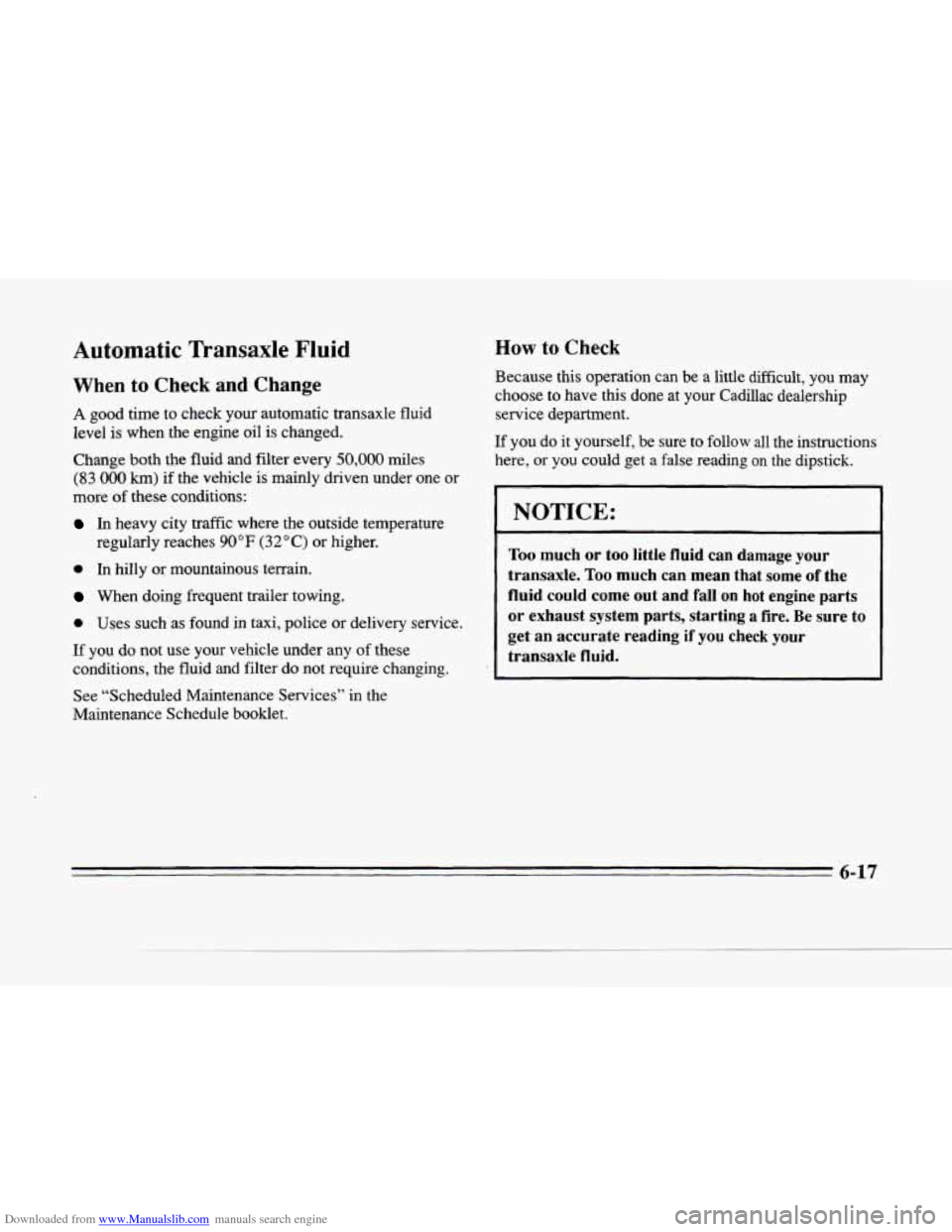
Downloaded from www.Manualslib.com manuals search engine %‘ .
Automatic Transaxle Fluid
When to Check and Change
A good time to check your automatic transaxle fluid
level is when the engine oil
is changed.
Change both the fluid
and filter every 50,000 miles
(83 000 km) if the vehicle is mainly driven under one or
more of these conditions:
In heavy city traffic where the outside temperature
regularly reaches
90°F (32°C) or higher.
0 In hilly or mountainous terrain.
When doing frequent trailer towing.
0 Uses such as found in taxi, police or delivery service,
If
you do not use your vehicle under any of these
conditions, the fluid and filter do not require changing.
See “Scheduled Maintenance Services”
in the
Maintenance Schedule
booklet.
How to Check
Because this operation can be a little difficult, you may
choose to have this done at your Cadillac dealership
service department.
If you do it yourself, be sure to follow
all the instructions
here, or you could get a false reading
on the dipstick.
I
NOTICE:
Too much or too little fluid can damage your
transaxle.
Too much can mean that some of the
fluid could come out and fall
on hot engine parts
or exhaust system parts, starting a fire. Be sure to
get an accurate reading if
you check your
transaxle fluid.
6-17
Page 277 of 354
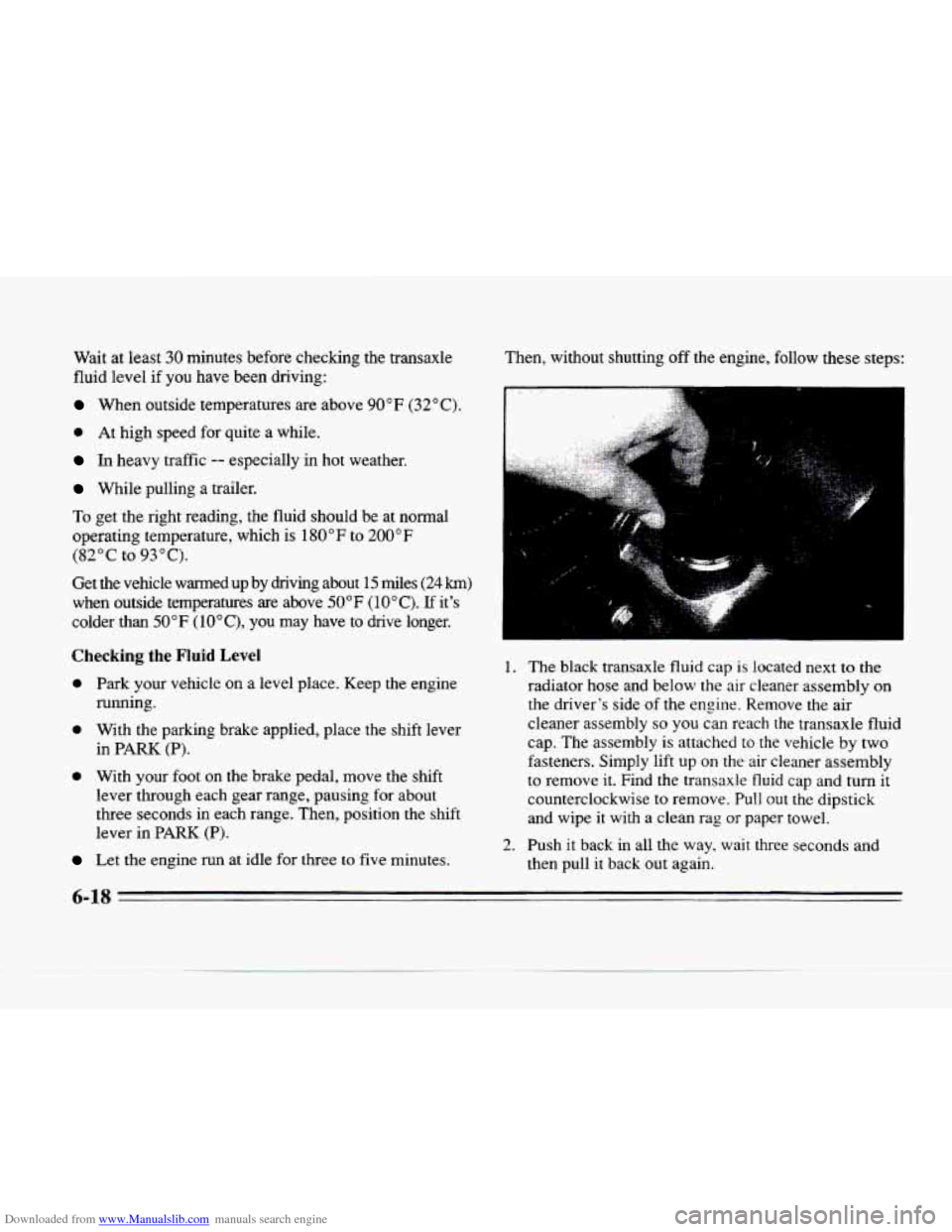
Downloaded from www.Manualslib.com manuals search engine Wait at least 30 minutes before checking the transaxle
fluid level if you have been driving:
When outside temperatures are above 90°F (32°C).
0 At high speed for quite a while.
In heavy traffic -- especially in hot weather.
While pulling a trailer.
To get the right reading, the fluid should be at normal
operating temperature, which is 180 OF to 200 OF
(82°C to 93°C).
Get the vehicle warmed up by driving about 15 miles (24 km)
when outside temperatures are above 50°F (10°C). If it's
colder
than 50°F (lO"C), you may have to drive longer.
Checking the Fluid Level
0 Park your vehicle on a level place. Keep the engine
0 With the parking brake applied, place the shift lever
0 With your foot on the brake pedal, move the shift
lever through each gear range, pausing for about
three seconds in each range. Then, position the shift
lever
in PARK (P).
running.
in
PARK (P).
Let the engine run at idle for three to five minutes. Then,
without shutting off the engine, follow these steps:
1. The black transaxle fluid cap is located next to the
radiator hose and below the air cleaner assembly
on
the driver's side of the engine. Remove the air
cleaner assembly so you can reach the transaxle fluid
cap, The assembly is attached to the vehicle
by two
fasteners. Simply lift up on the air cleaner assembly
to remove it. Find the transaxle fluid cap and turn it
counterclockwise to remove. Pull out the dipstick
and wipe it with
a clean rag or paper towel.
2. Push it back in all the way. wait three seconds and
then pull it back out again.
6-18
Page 297 of 354
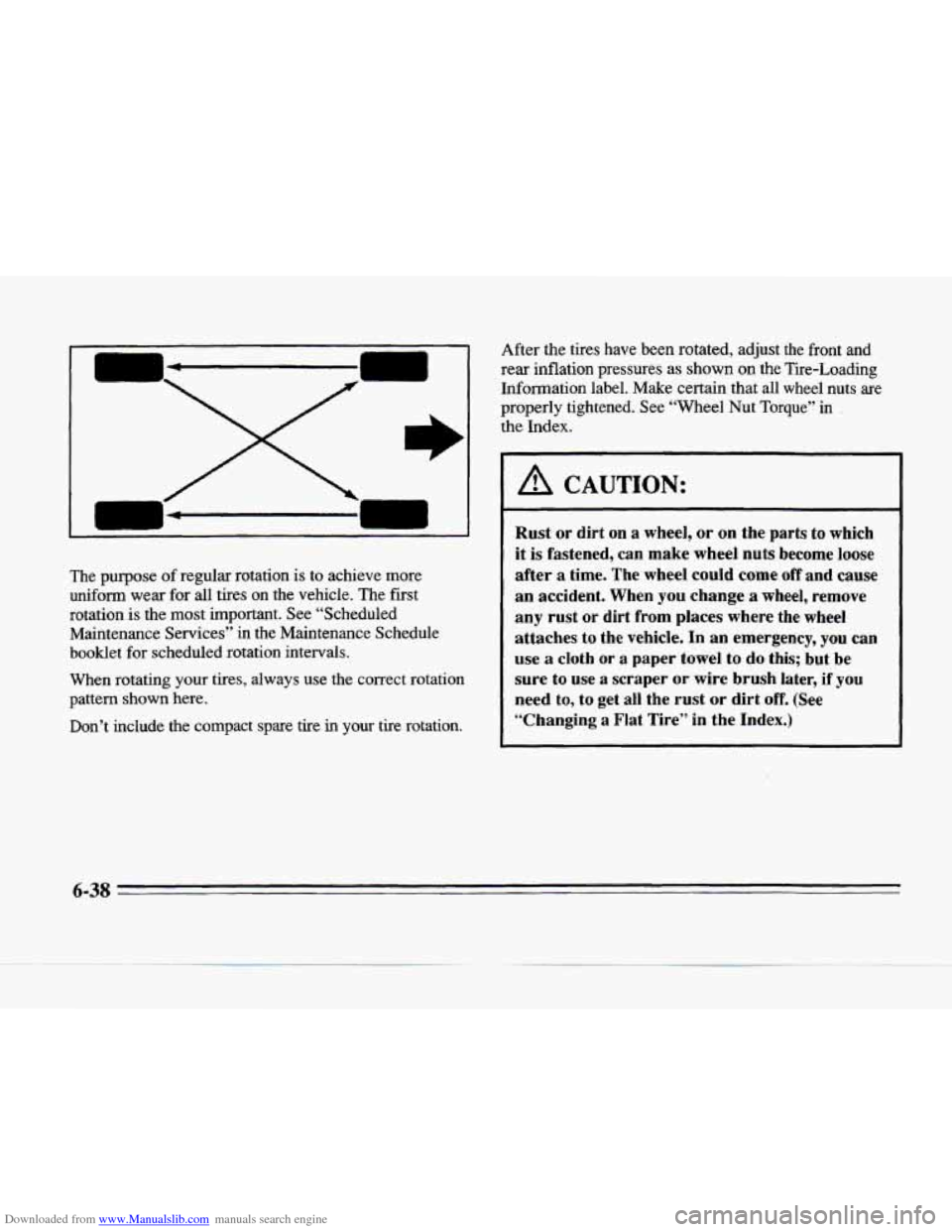
Downloaded from www.Manualslib.com manuals search engine The purpose of regular rotation is to achieve more
uniform wear for all tires on the vehicle. The first
rotation
is the most important. See “Scheduled
Maintenance Services”
in the Maintenance Schedule
booklet for scheduled rotation intervals.
When rotating your tires, always use the correct rotation
pattern shown here.
Don’t include the compact spare tire
in your tire rotation. After
the tires have been rotated, adjust the front and
rear inflation pressures
as shown on the Tire-Loading
Information label. Make certain that
all wheel nuts are
properly tightened. See “Wheel Nut Torque”.in
the Index.
A CAUTION:
Rust or dirt on a wheel, or on the parts to which
it is fastened, can make wheel nuts become loose
after
a time. The wheel could come off and cause
an accident. When you change a wheel, remove
any rust or dirt from places where the wheel
attaches
to the vehicle. In an emergency, you can
use
a cloth or a paper towel to do this; but be
sure to
use a scraper or wire brush later, if you
need to, to get all the rust or dirt
off. (See
“Changing a Flat Tire” in the Index.)
6-38 I
Page 304 of 354
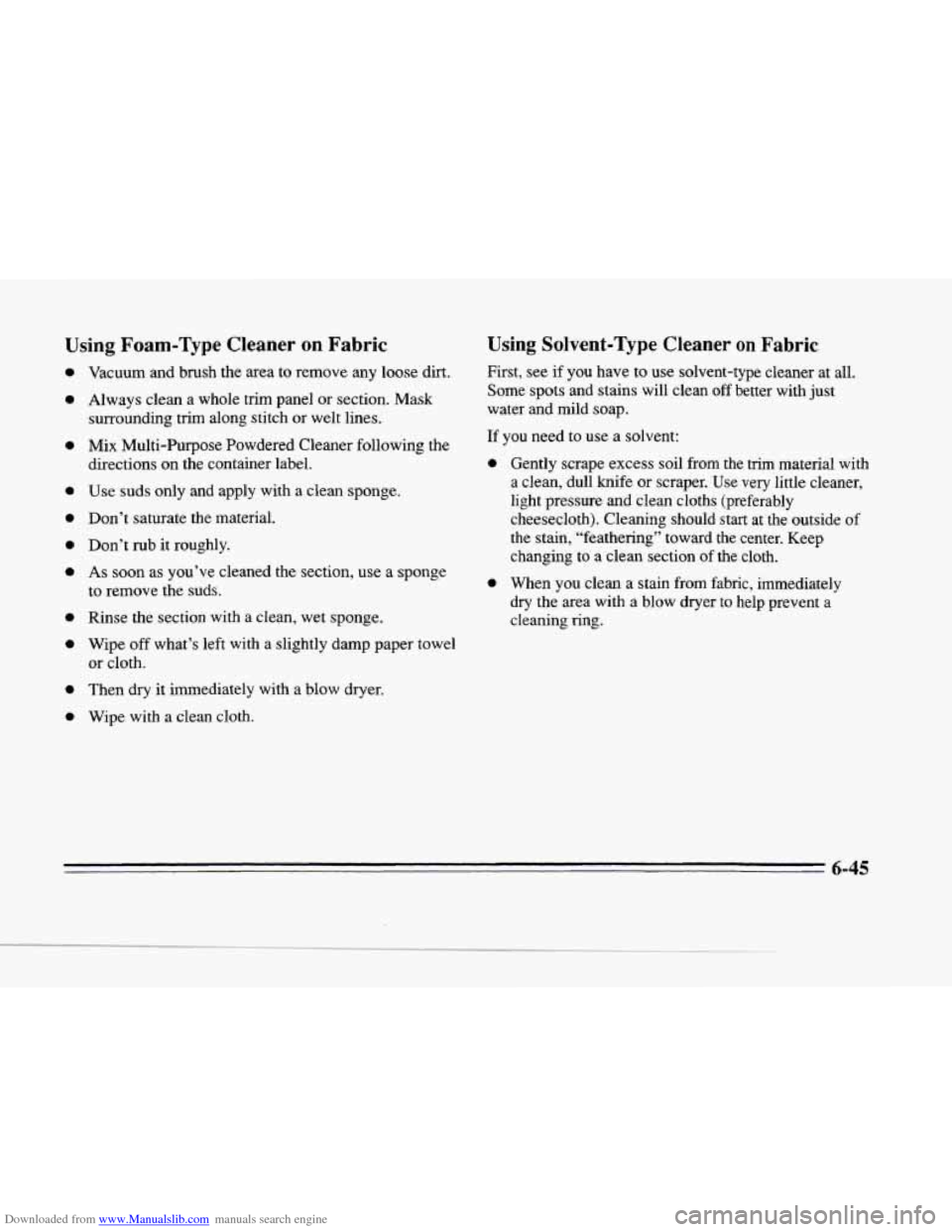
Downloaded from www.Manualslib.com manuals search engine Using Foam-Type Cleaner on Fabric
e
0
0
r-
e
e
0
0
1
e
0
Vacuum and brush the area to remove any loose dirt.
Always clean a whole trim panel or section. Mask
surrounding trim along stitch or welt lines.
Mix Multi-Purpose Powdered Cleaner following the
directions on the container label.
Use suds only and apply with a clean sponge.
Don’t saturate the material.
Don’t rub
it roughly.
As soon as you’ve cleaned the section, use a sponge
to remove the suds.
Rinse the section with a clean, wet sponge.
Wipe off what’s left with a slightly damp paper towel
or cloth.
Then dry it immediately with a blow dryer.
Wipe with
a clean cloth.
Using Solvent-Type Cleaner on Fabric
First, see if you have to use solvent-type cleaner at all.
Some spots and stains will clean
off better with just
water and mild soap.
If
you need to use a solvent:
0 Gently scrape excess soil from the trim material with
a clean, dull knife or scraper. Use very little cleaner,
light pressure and clean cloths (preferably
cheesecloth). Cleaning should
start at the. outside of
the stain, “feathering” toward the center. Keep
changing to a clean section
of the cloth.
0 When you clean a stain from fabric, immediately
dry the area with a blow dryer
to help prevent a
cleaning ring.
- 6-45
Page 306 of 354
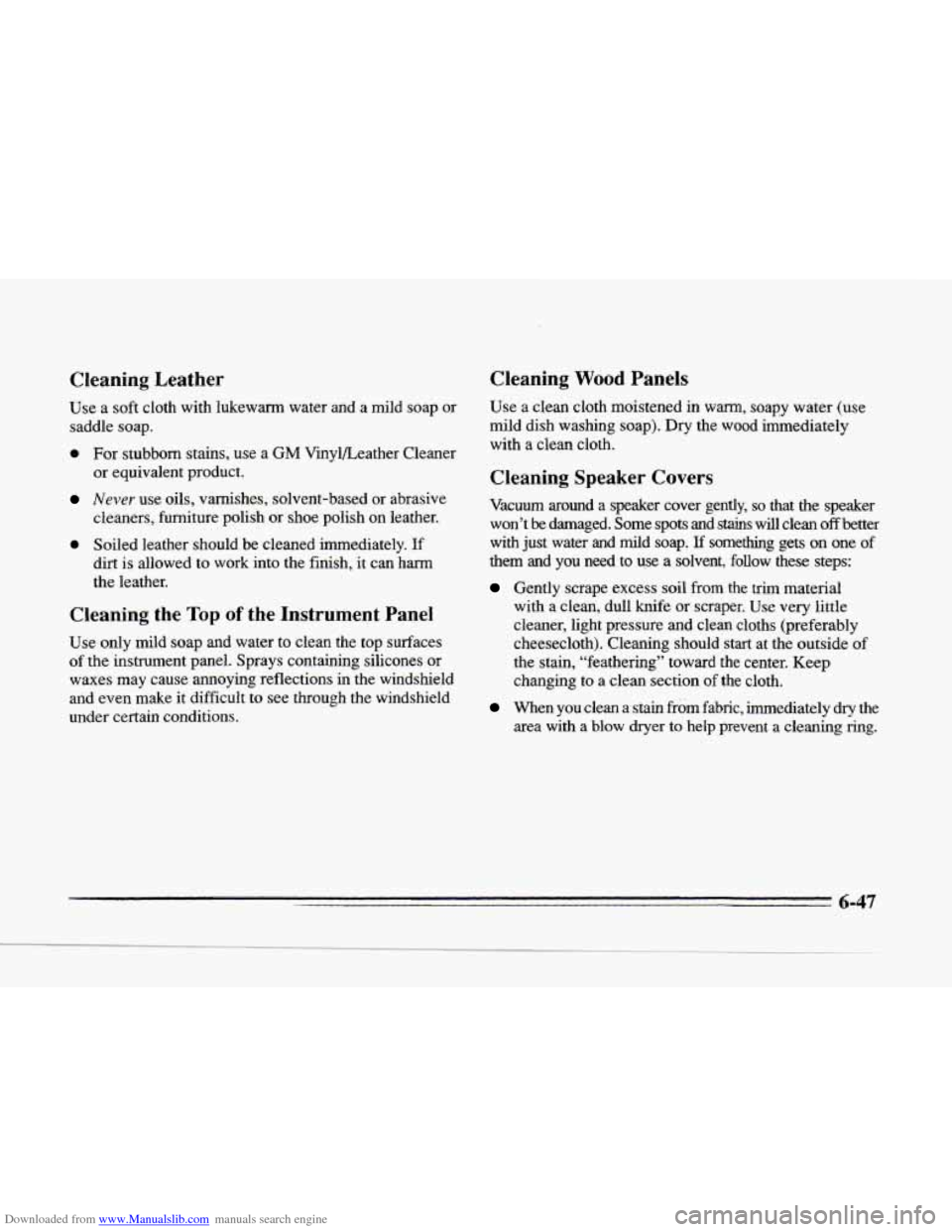
Downloaded from www.Manualslib.com manuals search engine Cleaning Leather
Use a soft cloth with lukewarm water and a mild soap or
saddle soap.
Cleaning Wood Panels
0 For stubborn stains, use a GM VinylLeather Cleaner
or equivalent product.
Never use oils, varnishes, solvent-based or abrasive
cleaners, furniture polish or shoe polish on leather.
dirt is allowed to work into the finish, it can harm
the leather.
0 Soiled leather should be cleaned immediately. If
Cleaning the Top of the Instrument Panel
Use only mild soap and water to clean the top surfaces
of the instrument panel. Sprays containing silicones or
waxes may cause annoying reflections in the windshield
and even make
it difficult to see through the windshield
under certain conditions. Use
a clean cloth moistened
in warm, soapy water (use
mild dish washing soap). Dry the
wood immediately
with
a clean cloth.
Cleaning Speaker Covers
Vacuum around a speaker cover gently, so that the speaker
won’t be damaged. Some spots and stains will clean off better
with just water
and mild soap. If something gets on one of
them and you need to use a solvent, follow these steps:
Gently scrape excess soil from the trim material
with
a clean, dull knife or scraper. Use very little
cleaner, light pressure and clean cloths (preferably
cheesecloth). Cleaning should start
at the outside of
the stain, “feathering” toward the center. Keep
changing to a clean section of the cloth.
When you clean a stain from fabric, immediately dry the
area with a blow dryer to help prevent a cleaning ring.
6-47
Page 308 of 354
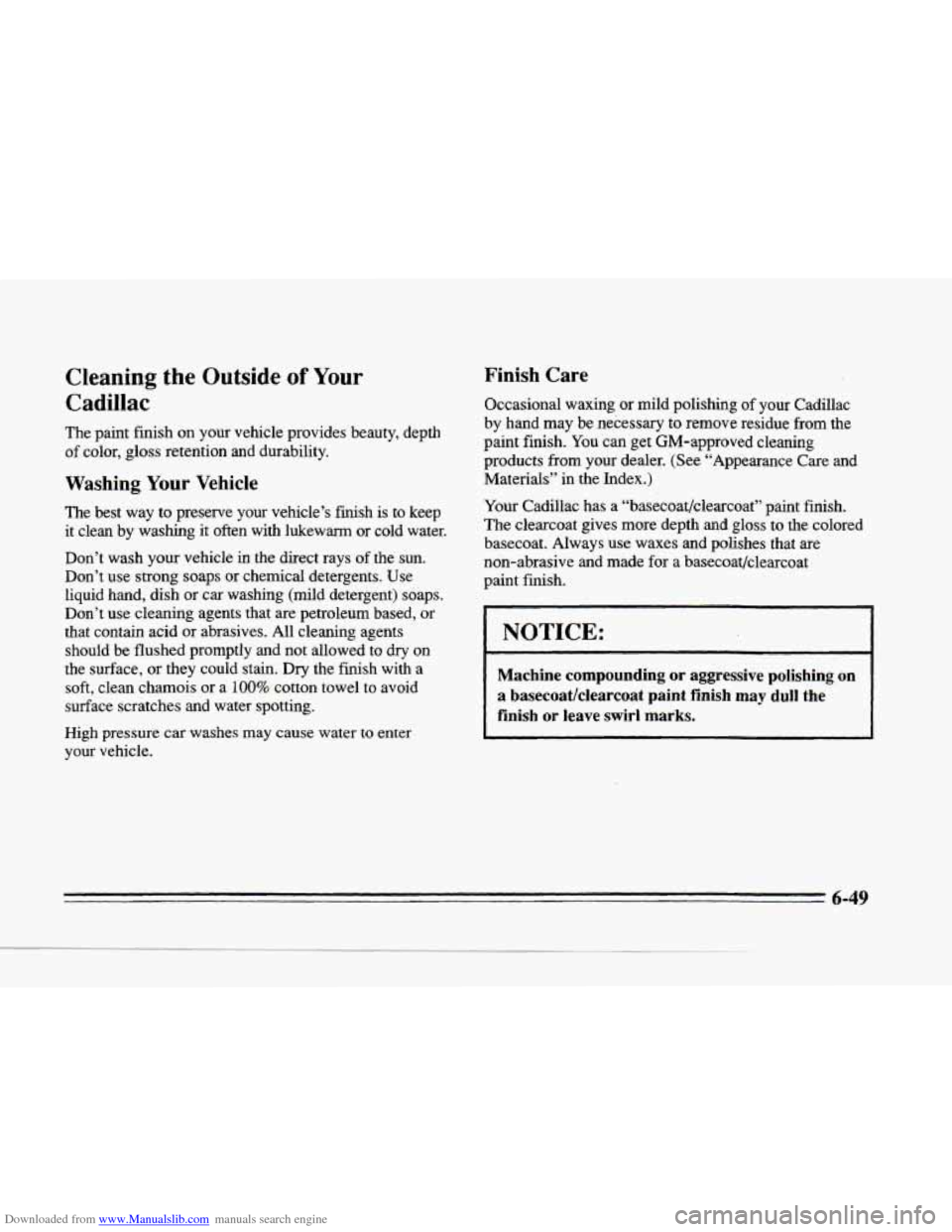
Downloaded from www.Manualslib.com manuals search engine c
zr
c
Cleaning the Outside of Your
Cadillac
The paint finish on your vehicle provides beauty, depth
of color, gloss retention and durability.
Washing Your Vehicle
The best way to preserve your vehicle’s fish is to keep
it clean by washing it often with lukewarm or cold water.
Don’t wash your vehicle
in the direct rays of the sun.
Don’t use strong soaps or chemical detergents. Use
liquid hand, dish or car washing (mild detergent) soaps.
Don’t use cleaning agents that are petroleum based, or
that contain acid or abrasives. All cleaning agents
should be flushed promptly and not allowed to dry on
the surface,
or they could stain. Dry the finish with a
soft, clean chamois
or a 100% cotton towel to avoid
surface scratches and water spotting.
High
pressure car washes may cause water to enter
your vehicle.
Finish Care
Occasional waxing or mild polishing of your Cadillac
by hand may be necessary to remove residue from the
paint finish. You can get GM-approved cleaning
products from your dealer. (See “Appearance Care and
Materials” in the Index.)
Your Cadillac has a “basecoat/clearcoat” paint finish.
The clearcoat gives more depth
and gloss to the colored
basecoat. Always use waxes and polishes that
are
non-abrasive and made for a basecoat/clearcoat
paint finish.
Machine compounding or aggressive polishing on
a basecoat/clearcoat paint finish may dull the
finish or leave swirl marks.
6-49
Page 309 of 354
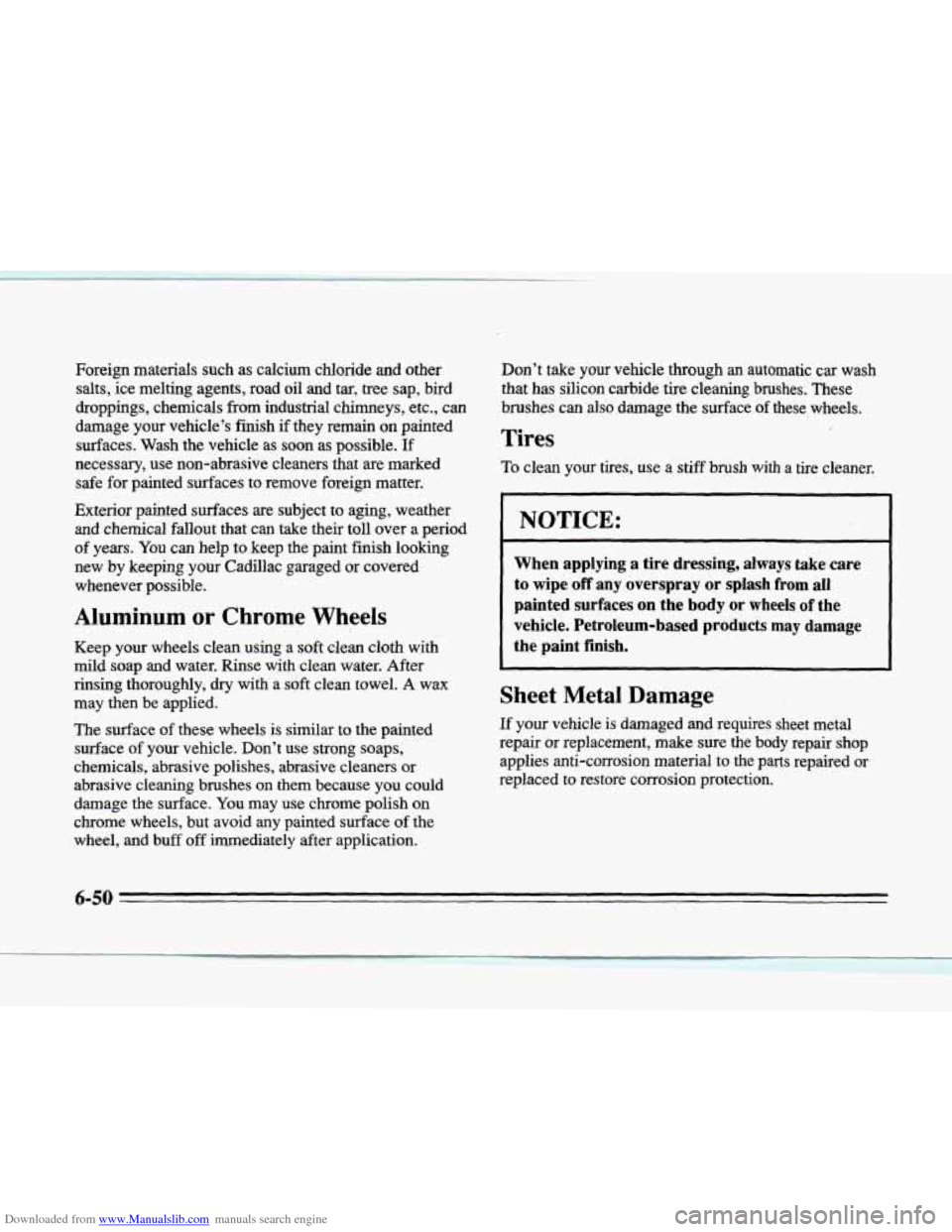
Downloaded from www.Manualslib.com manuals search engine Foreign materials such as calcium chloride and other
salts, ice melting agents, road oil and
tar, tree sap, bird
droppings, chemicals from industrial chimneys, etc., can
damage your vehicle’s finish if they remain on painted
surfaces. Wash the vehicle as soon as possible.
If
necessary, use non-abrasive cleaners that are marked
safe for painted surfaces to remove foreign matter.
Exterior painted surfaces are subject to aging, weather
and chemical fallout that can take their toll over a period
of years. You can help to keep the paint finish looking
new by keeping your Cadillac garaged or covered
whenever possible.
Aluminum or Chrome Wheels
Keep your wheels clean using a soft clean cloth with
mild soap and water. Rinse with clean water. After
rinsing thoroughly,
dry with a soft clean towel. A wax
may then be applied.
The surface of these wheels is similar to the painted
surface of your vehicle. Don’t use strong soaps,
chemicals, abrasive polishes, abrasive cleaners or
abrasive cleaning
brushes on them because you could
damage the surface. You may use chrome polish
on
chrome wheels, but avoid any painted surface of the
wheel, and
buff off immediately after application. Don’t
take your vehicle through an automatic car wash
that has silicon carbide tire cleaning brushes. These
brushes
can also damage the surface of these.wheels.
Tires
To clean your tires, use a stiff brush with a tire cleaner.
I NOTICE:
When applying a tire dressing, always take care
to wipe
off any overspray or splash from all
painted surfaces
on the body or wheels of the
vehicle. Petroleum-based
products may damage
the paint finish.
Sheet Metal Damage
If your vehicle is damaged and requires sheet metal
repair
or replacement, make sure the body repair shop
applies anti-corrosion material
to the parts repaired or
replaced to restore corrosion protection.
6-50
I
Page 331 of 354
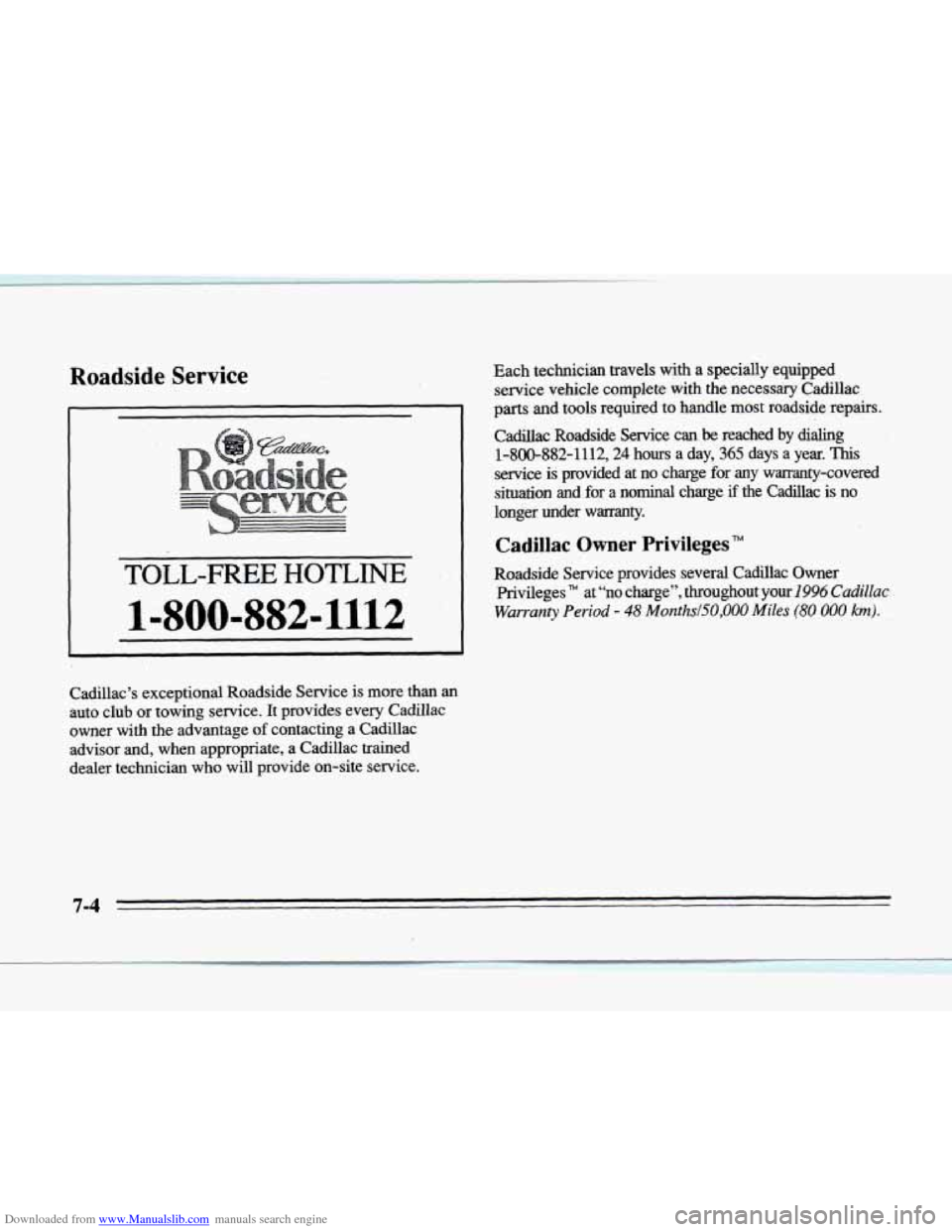
Downloaded from www.Manualslib.com manuals search engine Roadside Service
I
TOLL-FREE HOTLINE
1-800-882-1112
Each technician travels with a specially equipped
service vehicle complete with the necessary Cadillac
parts and tools required to handle most roadside repairs.
Cadillac Roadside Service can
be reached by dialing
1-800-882-1112,24 hours a day, 365 days a year. This
service is provided at no charge for any warranty-covered
situation and
for a nominal charge if the Cadillac is no
longer under warranty.
Cadillac Owner Privileges TM
Roadside Service provides several Cadillac Owner Privileges at
“no charge”, throughout your I996 Cadillac
Warranty Period - 48 Monthsf50,OOO Miles (80 000 km).
Cadillac’s exceptional Roadside Service is more than an
auto club or
towing service. It provides every Cadillac
owner with the advantage
of contacting a Cadillac
advisor and, when appropriate, a Cadillac trained
dealer technician
who will provide on-site service.
7-4
I
I
Page 332 of 354
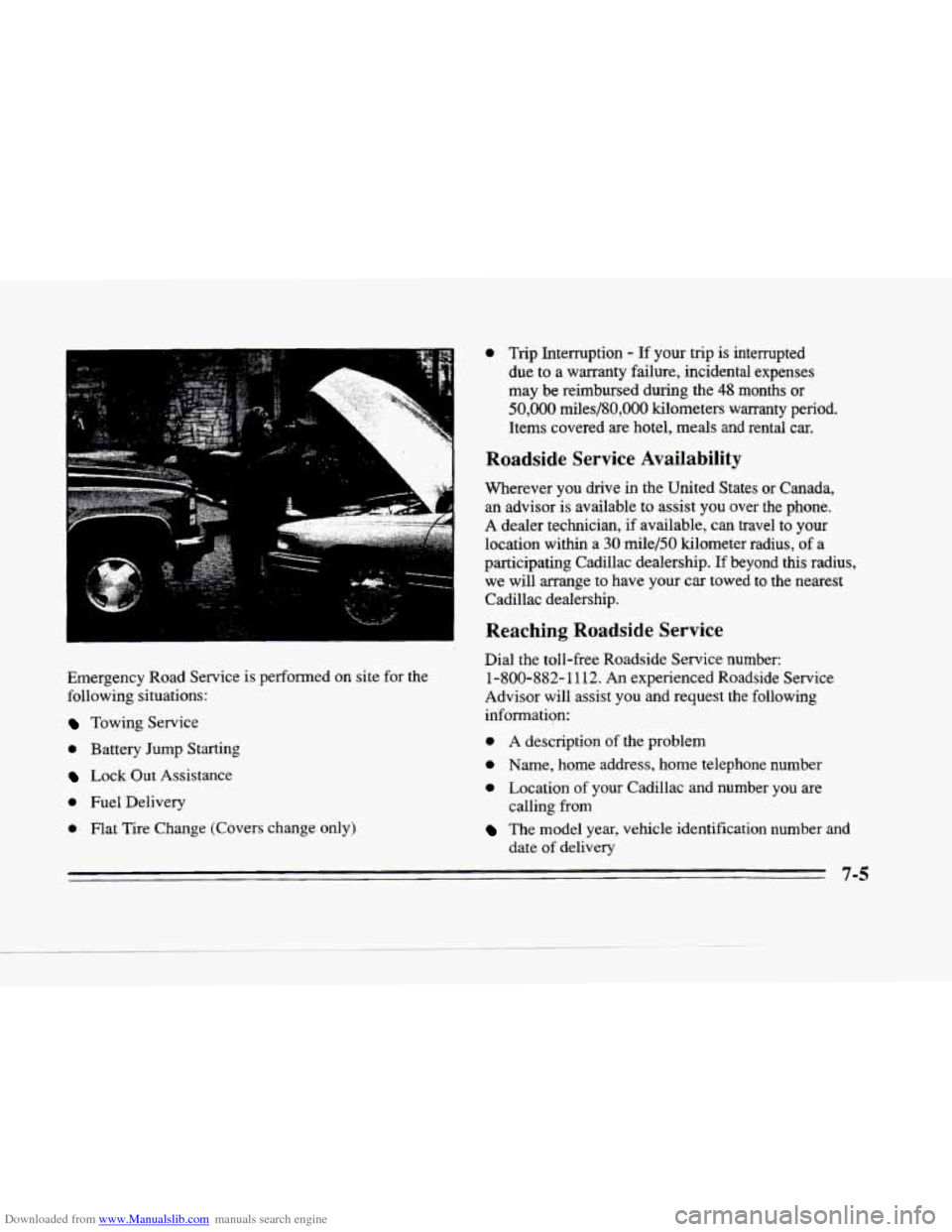
Downloaded from www.Manualslib.com manuals search engine .-
L I ..
Y .--.-
I
Emergency Road Service is performed on site for the
following situations:
Towing Service
0 Battery Jump Starting
Lock Out Assistance
0 Fuel Delivery
0 Flat Tire Change (Covers change only)
0 Trip Interruption - If your trip is interrupted
due to a warranty failure, incidental expenses
may
be reimbursed during the 48 months or
50,000 miles/80,000 kilometers warranty period.
Items covered are hotel, meals
and rental car.
Roadside Service Availability
Wherever you drive in the United States or Canada,
an advisor is available to assist you over the phone.
A dealer technician, if available, can travel to your
location within a
30 mile/50 kilometer radius, of a
participating Cadillac dealership. If beyond this radius,
we will arrange to have your car towed to the nearest
Cadillac dealership.
Reaching Roadside Service
Dial the toll-free Roadside Service number:
1-800-882-11 12. An experienced Roadside Service
Advisor will assist you
and request the following
information:
0 A description of the problem
0 Name, home address, home telephone number
0 Location of your Cadillac and number you are
The model year, vehicle identification number and
calling
from
date
of delivery
Page 345 of 354
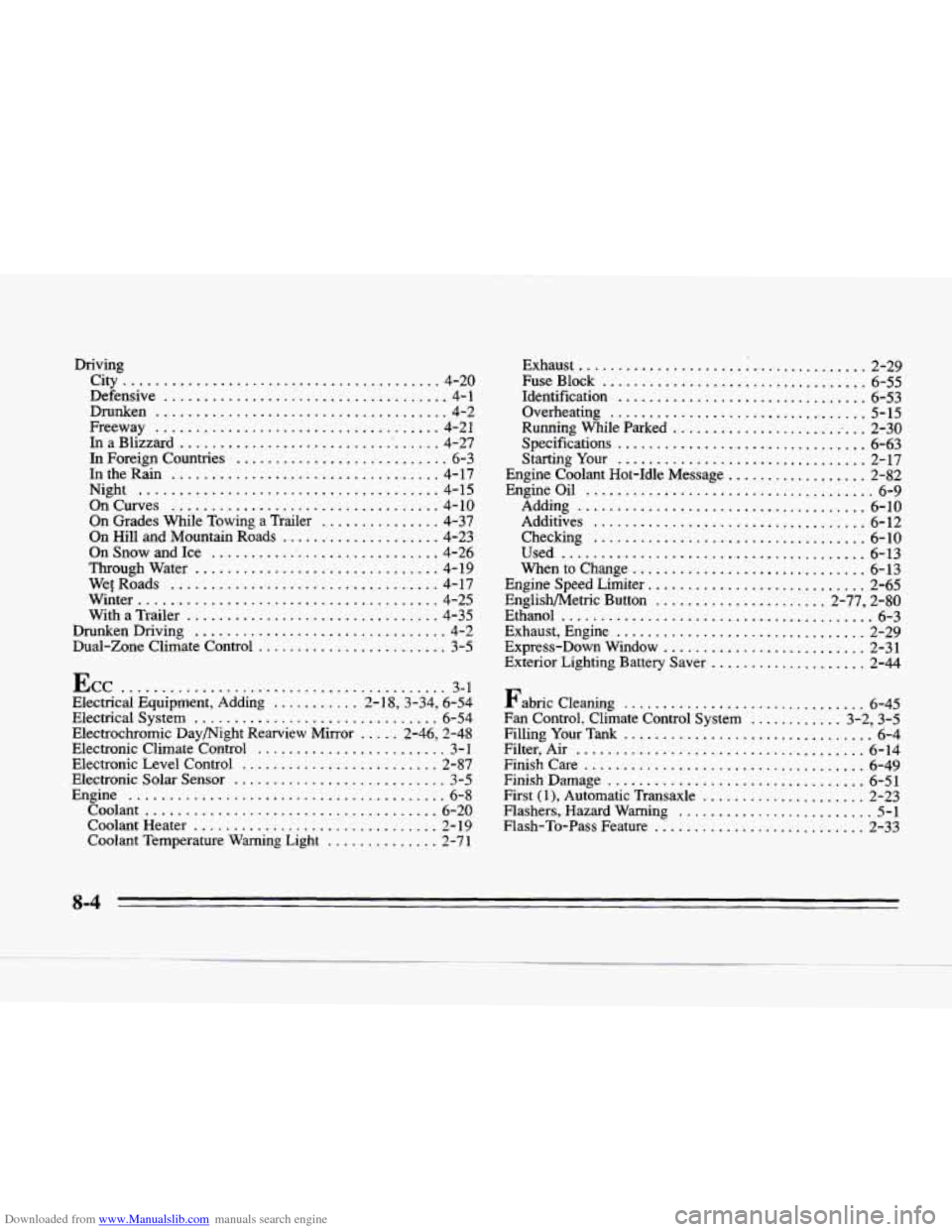
Downloaded from www.Manualslib.com manuals search engine Driving City
........................................ 4-20
Defensive
.................................... 4- 1
Drunken
..................................... 4-2
Freeway
.................................... 4-21
In a Blizzard .................................. 4-27
IntheRain
.................................. 4-17
Night
...................................... 4-15
In Foreign Countries ........................... 6-3
On Curves
.................................. 4- 10
On Grades While Towing a Trailer
............... 4-37
On Hill and Mountain Roads
.................... 4-23
Through Water
............................... 4- 19
Wet Roads
.................................. 4-17
Winter
...................................... 4-25
With a Trailer
................................ 4-35
DrunkenDriving
................................ 4-2
Dual-Zone Climate Control
........................ 3-5
On Snow and
Ice
.............................. 4-26
ECC ......................................... 3-1
Electrical Equipment. Adding
........... 2.18.3.34. 6.54
Electrical System
............................... 6-54
Electrochromic Daymight Rearview Mirror ..... 2.46. 2.48
Electronic Climate Control
......................... 3-1
Electronic Level Control
......................... 2-87
,Electronic Solar Sensor
........................... 3-5
Engine ........................................ 6-8
Coolant ..................................... 6-20
Coolant Heater
............................... 2- I9
Coolant Temperature Warning Light .............. 2-71 Exhaust
..................................... 2-29
FuseBlock
.................................. 6-55
Identification
................................ 6-53
Overheating
.................................. 5-15
Running While Parked
.......................... 2-30
Specifications
................................ 6-63
Engine Coolant Hot-Idle Message
.................. 2-82
Engineoil
..................................... 6-9
Adding ..................................... 6-10
Additives
................................... 6-12
Checking
................................... 6-10
Used
....................................... 6-13
When to Change
.............................. 6-13
Engine
Speed Limiter ............................ 2-65
English/Metric Button
...................... 2-77, 2-80
Ethanol
........................................ 6-3
Exhaust, Engine ................................ 2-29
Express-Down Window
.......................... 2-31
Exterior Lighting Battery Saver
.................... 2-44
StartingYour
................................ 2-17
Fabric Cleaning
............................... 6-45
Fan Control. Climate Control System
............ 3.2. 3.5
Filling Your Tank
................................ 6-4
Filter. Air ..................................... 6-14
Finish Care
.................................... 6-49
Finish Damage
................................. 6-51
First (1). Automatic Transaxle
..................... 2-23
Flashers.
. Hazard Warning ......................... 5-1
Flash-To-Pass Feature
........................... 2-33
8-4